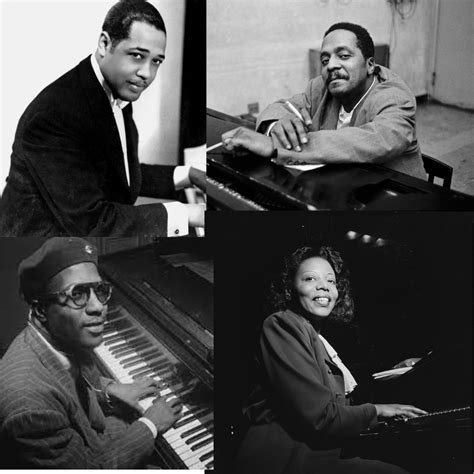The world of jazz piano is a realm of incredible technicality, creativity, and expressiveness. Top jazz pianists are not just skilled musicians; they are masters of their craft, with a deep understanding of harmony, melody, and rhythm. But what sets them apart from others? What are the legendary techniques that have been passed down through generations of jazz pianists, and how can one develop these skills to become a truly exceptional player?
To delve into this question, we must first examine the fundamental elements of jazz piano playing. At its core, jazz is about improvisation, creativity, and spontaneity. A good jazz pianist must have a strong foundation in harmony, being able to navigate complex chord progressions with ease. They must also possess a keen sense of melody, able to crafts solos that are both meaningful and memorable. And, of course, rhythm is essential, as jazz is deeply rooted in the rhythmic traditions of African-American music.
One of the most significant techniques employed by top jazz pianists is the use of harmonic substitutions. This involves replacing chords in a progression with alternative chords that still maintain the same harmonic function. For example, in a ii-V-I progression, a pianist might substitute the ii chord with a iii chord, or the V chord with a vii chord. This creates a sense of tension and release, adding depth and complexity to the music.
Another key technique is the use of reharmonization. This involves reinterpreting a chord progression in a new and innovative way, often by adding extended chords, altered dominants, or modal interchange. Reharmonization allows pianists to create fresh and exciting harmonies, even when working with familiar melodies or chord progressions.
In addition to these harmonic techniques, top jazz pianists are also masters of melodic improvisation. They have a deep understanding of melodic contour, able to crafts solos that are both lyrical and coherent. This involves a strong sense of motifs, or small melodic ideas, which can be developed and varied throughout a solo. It also requires a keen sense of phrasing, with a ability to create a sense of drama and narrative arc.
Rhythmic accuracy and flexibility are also essential for a top jazz pianist. They must be able to play with a strong sense of time, able to navigate complex rhythms and time signatures with ease. This involves a deep understanding of polyrhythms, or the interplay between multiple rhythms, as well as the ability to play with a relaxed, swinging feel.
To develop these legendary techniques, one must first establish a strong foundation in jazz piano playing. This involves practicing scales, arpeggios, and chord progressions, as well as listening to and transcribing the music of great jazz pianists. One must also develop a strong sense of ear, able to hear and internalize the complex harmonies and melodies of jazz.
Beyond technical practice, however, lies the realm of musicality and expression. A top jazz pianist must be able to convey emotion and feeling through their playing, able to connect with the audience on a deep and meaningful level. This involves a sense of vulnerability and openness, a willingness to take risks and be spontaneous in the moment.
In terms of specific techniques, there are several exercises and practices that can help develop the skills of a top jazz pianist. One useful exercise is to practice improvising over a static chord progression, using a variety of melodic motifs and rhythmic ideas. Another is to transcribe and learn the solos of great jazz pianists, analyzing their harmonic and melodic choices and incorporating these into one’s own playing.
The use of technology can also be a valuable tool for jazz pianists. Software such as MIDI sequencers and digital audio workstations can allow pianists to experiment with new sounds and textures, as well as to practice and rehearse in a more efficient and effective way.
In conclusion, becoming a top jazz pianist requires a deep understanding of harmony, melody, and rhythm, as well as a strong sense of musicality and expression. By mastering legendary techniques such as harmonic substitutions, reharmonization, and melodic improvisation, and by developing a strong foundation in jazz piano playing, one can become a truly exceptional player. With dedication, hard work, and a willingness to take risks and be spontaneous, anyone can achieve greatness in the world of jazz piano.
To become a great jazz pianist, one must be willing to put in the time and effort required to develop their skills. This involves a deep commitment to practice and study, as well as a willingness to take risks and be spontaneous in the moment.
Some of the most influential jazz pianists of all time include Oscar Peterson, known for his incredible technical ability and harmonic sophistication; Bill Evans, whose introspective and contemplative style has inspired generations of pianists; and Herbie Hancock, a true innovator and master of improvisation. These pianists, along with many others, have helped to shape the sound and style of jazz piano, and their music continues to inspire and influence pianists to this day.
What are some essential skills for a jazz pianist to develop?
+Some essential skills for a jazz pianist to develop include a strong foundation in harmony, melody, and rhythm, as well as the ability to improvise and be spontaneous in the moment. A good jazz pianist must also have a strong sense of ear, able to hear and internalize complex harmonies and melodies.
How can I improve my jazz piano playing?
+To improve your jazz piano playing, practice regularly, focusing on developing your skills in harmony, melody, and rhythm. Listen to and transcribe the music of great jazz pianists, and try to incorporate their techniques and ideas into your own playing. Also, be open to new experiences and challenges, and be willing to take risks and try new things.
What are some of the most important harmonic techniques for a jazz pianist to learn?
+Some of the most important harmonic techniques for a jazz pianist to learn include harmonic substitutions, reharmonization, and modal interchange. These techniques allow pianists to add complexity and depth to their playing, and to create fresh and exciting harmonies.
By following these tips and techniques, and by dedicating oneself to the study and practice of jazz piano, one can become a truly exceptional player, able to convey emotion and feeling through their music, and to connect with audiences on a deep and meaningful level. Whether you are a seasoned professional or just starting out, the world of jazz piano has much to offer, and with the right approach and mindset, anyone can achieve greatness in this incredible and rewarding genre of music.



